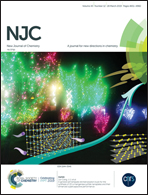Copper(i)-catalyzed asymmetric aza Diels–Alder reactions of azoalkenes toward fulvenes: a molecular electron density theory study†
Abstract
Uncatalyzed as well as catalyzed aza-Diels–Alder (ADA) reactions between 1,2-diaza-1,3-diene AD-2 and fulvene FU-3 in dichloromethane (DCM) at 25 °C were theoretically studied at the B3LYP-D3(BJ)/def2-TZVP(SMD,DCM)//B3LYP/6-31G(d)(SMD,DCM) computational level to shed light on the impacts of catalyst CuL (cation Cu+ chelated with N,N-bidentate ligand L). In excellent agreement with the experimental findings, the energetics analyses indicate that the uncatalyzed ADA reaction of AD-2 toward FU-3 leads to generation of cycloadduct CA-2n as the sole product in a quite C4–C7 regioselective and highly endo-stereoselective manner. The experimentally observed regioselectivity and endo-stereoselectivity can be rationalized through analysis of Parr functions and non-covalent interactions (NCIs), respectively. Within coordination of catalyst CuL to AD-2, the generated molecular complex AD-2-CuL participates in the catalyzed ADA reaction toward FU-3 which takes place in a complete C4–C7 regioselectivity and high endo-stereoselectivity as well as highly enantioselective manner yielding CA-2n as the sole product. Such a high enantioselectivity arises from the fact that the Re-face of AD-2-CuL is extremely covered by the bulky ligand L such that it cannot effectively be attacked by FU-3. The calculated second-order rate constant associated with the formation of CA-2n in the presence of catalyst in DCM at 25 °C is 2.2 × 106 (mol L−1)−1 s−1, which explains why this reaction can experimentally take place at a very low temperature of −20 °C to furnish CA-2n in a good yield. Both the uncatalyzed and catalyzed ADA reactions studied proceed through a two-stage one-step mechanism.



 Please wait while we load your content...
Please wait while we load your content...